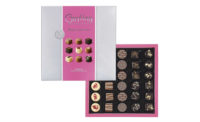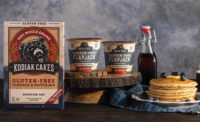Consumers cite budget, health, and lifestyle considerations as the top factors impacting decreased chocolate consumption in 2022, according to a 2023 Innova Category Survey. To solidify chocolate products as a permissible indulgence to consumers, manufacturers must address key consumer motivators, including flavors and textures that amplify experiences.
With these factors in mind, Candy Industry Senior Editor Liz Parker was able to talk to acclaimed Chocolatier and Pastry Chef Angela Borah, head chocolatier, Kreuther Handcrafted Chocolate, on ingredient selection and applications that can redefine the value of confectionery products.
LP: How can manufacturers solidify chocolate products as a “permissible indulgence” to consumers?
Angela Borah: Unique flavor profiles in chocolate products, whether bold or global flavors, can provide consumers with exciting experiences through food. Incorporating innovative flavors in a familiar recipe concept can be more accessible to consumers. I developed an Almond Halva and Sesame Ganache Bar recipe in which the main component is halva, a Mediterranean confection, presented in a familiar candy bar format that can instantly transport the consumer to a different culture. Storytelling around innovative flavors promises consumers an amplified experience and justifies why a particular product is a permissible indulgence.
LP: Can you share some tips on ingredient selection and application that can change confectionery products?
AB: Over the last decade, plant-based alternatives have increased in popularity and global consumers have been more discerning in finding indulgent food which is accessible without compromising on flavor. In dairy-free recipes, it’s important to find plant-based alternatives that continue to deliver on indulgence. Ingredients such as fruit puree or plant-based milk often contain more water and less fat than dairy ingredients. When creating plant-based chocolate ganache recipes, I use natural emulsifiers like konjac gum. Konjac gum can provide texture and control the water activity of the ganache. Konjac gum is water soluble dietary fiber derived from the konjac plant that is used to thicken, stabilize, emulsify, and suspend ingredients.
Additionally, I’ve developed chocolate ganache recipes utilizing almond paste and almond milk, plant-based ingredients that contribute to attributes consumers expect in a chocolate product, including flavor and indulgent mouthfeel. Almond paste, while an unusual ingredient for a chocolate ganache, can contribute a creamy and smooth texture. This plant-based Almond Milk Horchata Bar features vegan milk chocolate ganache made with almond milk, a versatile base providing frothiness and pairing well with the flavors of horchata.
LP: Can you talk about your Almond Halva and Sesame Ganache Bar innovation, as well as your Almond Milk Horchata Bar, and Almond and Peach Tart Bonbon?
AB: All three recipes highlight the diversity of texture experiences that almonds can provide—creamy, frothy, flakey, crunchy, and crumbly—that can answer to consumers’ interest in being delighted and intrigued by chocolate products.
The main component in the Almond Halva and Sesame Ganache Bar is halva, which is traditionally made with tahini. To intensify the nuttiness of the halva, this recipe uses almond praline instead, made with blanched almonds. By controlling the roasting process of the almonds, rather than having a mild base, the almond halva becomes the star of the recipe. The flakey texture of the almond halva paired with the crumbly texture of an almond sablé, makes it a fun and enjoyable but elevated version of the traditional confection.
The Almond Milk Horchata Bar uses a plant-based milk chocolate containing ground almonds as one of the ingredients along with almond ingredients that provide the creaminess and frothiness often found in horchata. Instead of using water as the base, this recipe starts with almond milk to boost almond flavor, reinforced with toasted almonds and brown rice. Almonds are a great base to carry and enhance the cinnamon and coconut flavor in horchata, and this recipe answers global consumers’ continued interest in plant-based alternatives without compromising on the attributes consumers expect in a chocolate product, including indulgent mouthfeel.
The Almond and Peach Tart Bonbon recipe includes almond paste, an unusual ingredient to use in a chocolate ganache, contributing to the creamy, smooth and refined texture when blended into white chocolate and vanilla. The crunchy texture of the almond feuilletine layer as the tart crust can surprise the consumer in contrast to the smooth filling.
LP: Any ingredient trend predictions for the rest of 2023 or going into 2024?
AB: Many ingredients that were once exclusively popular in Asian communities will be brought to the mainstream. Ube, which is a sweet purple yam from the Philippines, is being used in familiar formats like ube pretzels. The resurgence and popularity of bubble tea, or boba, which originally started in Taiwan, is fueling innovation in desserts, pastries, and even chocolate bonbons. Asian citrus such as kalamansi, yuzu and sudachi are popping up in restaurant dessert menus. This trend reflects consumers’ continuous desire for global flavors and exposure to diverse cuisines.




